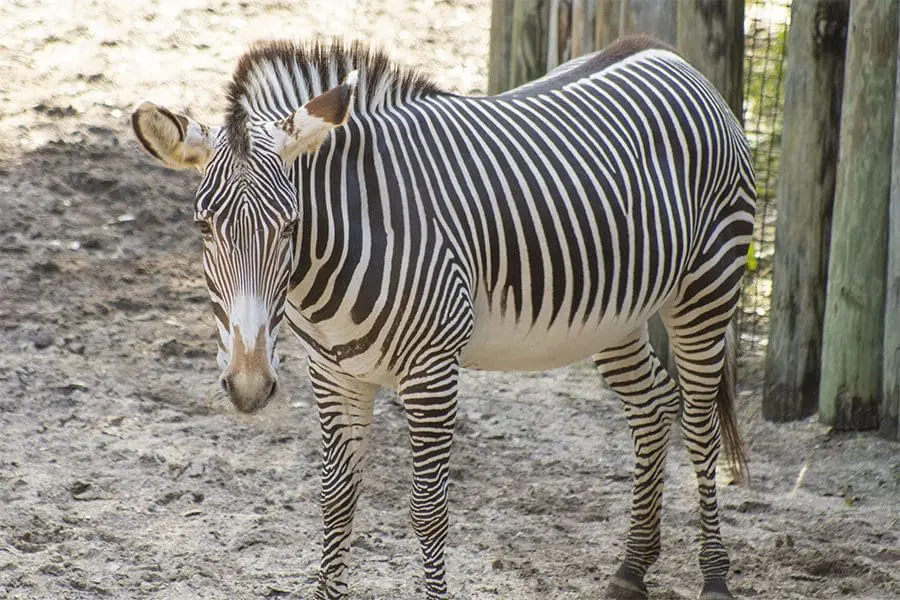

Zebra Iggy gave birth to a male foal named Ziggy in June 2022!
Here at the Zoo, we pride ourselves in providing a safe haven for many endangered species. In celebration of Endangered Species Day (May 20), we’re giving you a closer look at some of the threatened animals that call the Zoo home and the work that we’re doing to help their counterparts in their natural range.
Native to Kenya, this species of antelope is critically endangered due to habitat loss and poaching. In late 2020, we welcomed our first-ever Eastern bongos to the Zoo: now-6-year-old male Sebastian and now-4-year-old female Clover. This pair was matched by the Association of Zoos and Aquariums’ Species Survival Plan (SSP). SSPs manage the populations of animals within AZA-accredited zoos to ensure healthy, genetically diverse groups. Clover and Sebastian welcomed a bouncing baby bongo in 2021 – and again in 2022! We hope to continue welcoming calves in order to boost their population.
The United States’ most endangered bird lives at the Zoo in a behind-the-scenes habitat. The Florida grasshopper sparrow first arrived at the Zoo in September 2019 after we recognized the need to keep these uniquely Floridian birds in our state and join the breeding program for these sparrows. This species is only found in a few areas in Central and South Florida and has lost approximately 85% of its natural habitat to agriculture. As of 2021, just over 100 members of their species were detected in their natural range. Fortunately, your Zoo is breeding this endangered species. Several chicks have hatched already this year, all of which will be released into their natural range to boost the population of their species.
Our Sea Turtle Healing Center cares for sick and injured sea turtles found along the nearby coast. The majority of patients that come into the rehabilitation facility are juvenile green sea turtles. It may be hard to believe that this species is endangered as we’ve already treated over 60 individuals so far this year! Their main threats include boat strikes, plastics in the ocean, injuries from fishing gear like line and hooks, climate change and poaching. Along with other rehabilitation centers in coastal communities around the world, our Healing Center provides the rest, medicine and food needed to nurse these turtles back to health with the hope of returning them to the water.
The main threats to these majestic animals are poaching, climate change, habitat loss and competition with livestock. With just around 3,000 Grévy’s zebras left in their natural range, the work that organizations like Grévy’s Zebra Trust do to protect this species is paramount to their survival. Here at the Zoo, we are thrilled to soon welcome our first-ever baby zebras! Two of our females, Iggy and Lauren, are pregnant and expecting offspring in the near future. Our three female zebras were matched to breed with male Bakari as part of the SSP for this species, which is especially important for the endangered Grévy’s zebra.
These tiny dune-dwellers are found only on a small island between Florida and Alabama and are integral to their ecosystem. Here at the Zoo, we have developed a breeding program for Perdido Key beach mice, and we’ve had success returning the individuals born at our Zoo to their natural habitat. In fact, just this year, we successfully bred this species and welcomed 20 pups into the world! These younglings and their parents provide a safeguard for their species in their natural range.
As seed dispersers, these striking birds are an important part of the ecology of their native forests. The wrinkled hornbill is endangered due to habitat loss. In the past, we have supported Borneo Nature Foundation‘s efforts to survey the Rungan Forest of Indonesia through our Quarters for Conservation program. The Foundation’s surveys are a critical step in protecting and restoring this habitat for hornbills, orangutans and other species teetering on the edge of extinction. In addition, we are home to a breeding pair of wrinkled hornbills: Morticia and Gomez. This pair, who have had multiple chicks together, are helping to boost the population of this important species.
While we realize it can be upsetting to learn about animal populations that are threatened with extinction, it’s important to find out what you (and local zoos, aquariums and other organizations) can do to help.
It’s up to all of us to create a better future for wildlife. Consider donating to a nonprofit organization that works to help animals, volunteering to help us restore the Indian River Lagoon, seeking out eco-friendly cleaning products, cutting back on single-use plastics or just visiting the Zoo and supporting our conservation programs.
Brevard Zoo is an independent, not-for-profit organization that receives no recurring government funding for our operating costs. Your generous support enables us to continue to serve our community and continue our vital animal wellness, education and conservation programs.